+ データを開く
データを開く
- 基本情報
基本情報
| 登録情報 | データベース: PDB / ID: 3bxq | ||||||
|---|---|---|---|---|---|---|---|
| タイトル | The structure of a mutant insulin uncouples receptor binding from protein allostery. An electrostatic block to the TR transition | ||||||
 要素 要素 |
| ||||||
 キーワード キーワード | HORMONE / TR transition / Electrostatic block / Protein allostery / Receptor binding | ||||||
| 機能・相同性 |  機能・相同性情報 機能・相同性情報negative regulation of glycogen catabolic process / positive regulation of nitric oxide mediated signal transduction / negative regulation of fatty acid metabolic process / negative regulation of feeding behavior / Signaling by Insulin receptor / IRS activation / regulation of protein secretion / Insulin processing / positive regulation of peptide hormone secretion / positive regulation of respiratory burst ...negative regulation of glycogen catabolic process / positive regulation of nitric oxide mediated signal transduction / negative regulation of fatty acid metabolic process / negative regulation of feeding behavior / Signaling by Insulin receptor / IRS activation / regulation of protein secretion / Insulin processing / positive regulation of peptide hormone secretion / positive regulation of respiratory burst / negative regulation of acute inflammatory response / Regulation of gene expression in beta cells / alpha-beta T cell activation / positive regulation of dendritic spine maintenance / Synthesis, secretion, and deacylation of Ghrelin / activation of protein kinase B activity / negative regulation of respiratory burst involved in inflammatory response / negative regulation of protein secretion / negative regulation of gluconeogenesis / positive regulation of insulin receptor signaling pathway / positive regulation of glycogen biosynthetic process / fatty acid homeostasis / Signal attenuation / FOXO-mediated transcription of oxidative stress, metabolic and neuronal genes / negative regulation of lipid catabolic process / positive regulation of lipid biosynthetic process / negative regulation of oxidative stress-induced intrinsic apoptotic signaling pathway / regulation of protein localization to plasma membrane / nitric oxide-cGMP-mediated signaling / transport vesicle / COPI-mediated anterograde transport / positive regulation of nitric-oxide synthase activity / Insulin receptor recycling / negative regulation of reactive oxygen species biosynthetic process / positive regulation of brown fat cell differentiation / insulin-like growth factor receptor binding / NPAS4 regulates expression of target genes / neuron projection maintenance / endoplasmic reticulum-Golgi intermediate compartment membrane / positive regulation of mitotic nuclear division / Insulin receptor signalling cascade / positive regulation of glycolytic process / positive regulation of cytokine production / endosome lumen / positive regulation of long-term synaptic potentiation / acute-phase response / positive regulation of protein secretion / positive regulation of D-glucose import across plasma membrane / insulin receptor binding / positive regulation of cell differentiation / Regulation of insulin secretion / wound healing / positive regulation of neuron projection development / hormone activity / negative regulation of protein catabolic process / regulation of synaptic plasticity / positive regulation of protein localization to nucleus / Golgi lumen / cognition / vasodilation / glucose metabolic process / insulin receptor signaling pathway / cell-cell signaling / glucose homeostasis / regulation of protein localization / PI5P, PP2A and IER3 Regulate PI3K/AKT Signaling / positive regulation of cell growth / protease binding / secretory granule lumen / positive regulation of canonical NF-kappaB signal transduction / positive regulation of phosphatidylinositol 3-kinase/protein kinase B signal transduction / positive regulation of MAPK cascade / positive regulation of cell migration / G protein-coupled receptor signaling pathway / endoplasmic reticulum lumen / Amyloid fiber formation / Golgi membrane / negative regulation of gene expression / positive regulation of cell population proliferation / positive regulation of gene expression / regulation of DNA-templated transcription / extracellular space / extracellular region / identical protein binding 類似検索 - 分子機能 | ||||||
| 手法 |  X線回折 / X線回折 /  シンクロトロン / シンクロトロン /  分子置換 / 解像度: 1.3 Å 分子置換 / 解像度: 1.3 Å | ||||||
 データ登録者 データ登録者 | Wan, Z.L. / Huang, K. / Hu, S.Q. / Whittaker, J. / Weiss, M.A. | ||||||
 引用 引用 |  ジャーナル: J.Biol.Chem. / 年: 2008 ジャーナル: J.Biol.Chem. / 年: 2008タイトル: The structure of a mutant insulin uncouples receptor binding from protein allostery. An electrostatic block to the TR transition. 著者: Wan, Z.L. / Huang, K. / Hu, S.Q. / Whittaker, J. / Weiss, M.A. #1:  ジャーナル: J.Biol.Chem. / 年: 2008 ジャーナル: J.Biol.Chem. / 年: 2008タイトル: Design of an active ultrastable single-chain insulin analog: synthesis, structure, and therapeutic implications. 著者: Hua, Q.X. / Nakagawa, S.H. / Jia, W. / Huang, K. / Phillips, N.B. / Hu, S.Q. / Weiss, M.A. #2:  ジャーナル: Philos.Trans.R.Soc.London,Ser.B / 年: 1988 ジャーナル: Philos.Trans.R.Soc.London,Ser.B / 年: 1988タイトル: The structure of 2zn pig insulin crystal at 1.5 A resolution 著者: Baker, E.N. / Blujdell, T.L. / Cutfield, J.F. / Cutfield, S.M. / Dodson, E.J. / Dodson, G.G. / Hodgkin, D. / Isaacs, N.W. / Reynolds, C.D. #3:  ジャーナル: Nature / 年: 1976 ジャーナル: Nature / 年: 1976タイトル: Structure of insulin in 4-zinc insulin 著者: Bentley, G. / Dodson, E. / Dodson, G. / Hodgkin, D. / Mercola, D. #4:  ジャーナル: Nature / 年: 1989 ジャーナル: Nature / 年: 1989タイトル: Phenol stabilizes more helix in a new symmetrical zinc insulin hexamer 著者: Derewenda, U. / Derewenda, Z. / Dodson, E. / Dodson, G. / Reynold, C. / Smith, G. / Sparks, C. / Swenson, D. #5:  ジャーナル: J.Biol.Chem. / 年: 2006 ジャーナル: J.Biol.Chem. / 年: 2006タイトル: Toward the active conformation of insulin: stereospecific modulation of a structural swith in the B chain 著者: Hua, Q.X. / Nakagawa, S. / Hu, S.Q. / Jia, W. / Wang, S. / Weiss, M.A. | ||||||
| 履歴 |
|
- 構造の表示
構造の表示
| 構造ビューア | 分子:  Molmil Molmil Jmol/JSmol Jmol/JSmol |
|---|
- ダウンロードとリンク
ダウンロードとリンク
- ダウンロード
ダウンロード
| PDBx/mmCIF形式 |  3bxq.cif.gz 3bxq.cif.gz | 52.2 KB | 表示 |  PDBx/mmCIF形式 PDBx/mmCIF形式 |
|---|---|---|---|---|
| PDB形式 |  pdb3bxq.ent.gz pdb3bxq.ent.gz | 39 KB | 表示 |  PDB形式 PDB形式 |
| PDBx/mmJSON形式 |  3bxq.json.gz 3bxq.json.gz | ツリー表示 |  PDBx/mmJSON形式 PDBx/mmJSON形式 | |
| その他 |  その他のダウンロード その他のダウンロード |
-検証レポート
| 文書・要旨 |  3bxq_validation.pdf.gz 3bxq_validation.pdf.gz | 438.6 KB | 表示 |  wwPDB検証レポート wwPDB検証レポート |
|---|---|---|---|---|
| 文書・詳細版 |  3bxq_full_validation.pdf.gz 3bxq_full_validation.pdf.gz | 440.9 KB | 表示 | |
| XML形式データ |  3bxq_validation.xml.gz 3bxq_validation.xml.gz | 7.8 KB | 表示 | |
| CIF形式データ |  3bxq_validation.cif.gz 3bxq_validation.cif.gz | 10.3 KB | 表示 | |
| アーカイブディレクトリ |  https://data.pdbj.org/pub/pdb/validation_reports/bx/3bxq https://data.pdbj.org/pub/pdb/validation_reports/bx/3bxq ftp://data.pdbj.org/pub/pdb/validation_reports/bx/3bxq ftp://data.pdbj.org/pub/pdb/validation_reports/bx/3bxq | HTTPS FTP |
-関連構造データ
| 関連構造データ | 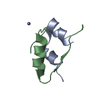 4insS S: 精密化の開始モデル |
|---|---|
| 類似構造データ |
- リンク
リンク
- 集合体
集合体
| 登録構造単位 | 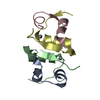
| ||||||||||||||||||
|---|---|---|---|---|---|---|---|---|---|---|---|---|---|---|---|---|---|---|---|
| 1 | 
| ||||||||||||||||||
| 単位格子 |
| ||||||||||||||||||
| Components on special symmetry positions |
|
- 要素
要素
| #1: タンパク質・ペプチド | 分子量: 2383.698 Da / 分子数: 2 / 由来タイプ: 合成 / 参照: UniProt: P01308 #2: タンパク質・ペプチド | 分子量: 3453.000 Da / 分子数: 2 / Mutation: R29H / 由来タイプ: 合成 / 参照: UniProt: P01308 #3: 化合物 | #4: 水 | ChemComp-HOH / | Has protein modification | Y | |
|---|
-実験情報
-実験
| 実験 | 手法:  X線回折 / 使用した結晶の数: 1 X線回折 / 使用した結晶の数: 1 |
|---|
- 試料調製
試料調製
| 結晶 | マシュー密度: 1.86 Å3/Da / 溶媒含有率: 33.75 % |
|---|---|
| 結晶化 | 温度: 298 K / 手法: 蒸気拡散法, ハンギングドロップ法 / pH: 8 詳細: 0.02 M Tris, 0.05 M sodium citrate, 5% acetone, 0.03% phenol, 0.01% zinc acetate, pH 8.0, VAPOR DIFFUSION, HANGING DROP, temperature 298K |
-データ収集
| 回折 | 平均測定温度: 100 K |
|---|---|
| 放射光源 | 由来:  シンクロトロン / サイト: シンクロトロン / サイト:  ALS ALS  / ビームライン: 4.2.2 / 波長: 1.033 Å / ビームライン: 4.2.2 / 波長: 1.033 Å |
| 検出器 | 検出器: CCD / 日付: 2006年9月21日 / 詳細: mirros |
| 放射 | モノクロメーター: graphite / プロトコル: SINGLE WAVELENGTH / 単色(M)・ラウエ(L): M / 散乱光タイプ: x-ray |
| 放射波長 | 波長: 1.033 Å / 相対比: 1 |
| 反射 | 解像度: 1.3→30.62 Å / Num. all: 40193 / Num. obs: 39411 / % possible obs: 95.4 % / Observed criterion σ(F): 0 / Observed criterion σ(I): 0 / 冗長度: 5.11 % / Biso Wilson estimate: 13.9 Å2 / Rmerge(I) obs: 0.04 / Net I/σ(I): 21.2 |
| 反射 シェル | 解像度: 1.3→1.38 Å / 冗長度: 2.89 % / Rmerge(I) obs: 0.132 / Mean I/σ(I) obs: 10 / Num. unique all: 4876 / % possible all: 77.9 |
- 解析
解析
| ソフトウェア |
| |||||||||||||||||||||||||
|---|---|---|---|---|---|---|---|---|---|---|---|---|---|---|---|---|---|---|---|---|---|---|---|---|---|---|
| 精密化 | 構造決定の手法:  分子置換 分子置換開始モデル: 4INS 解像度: 1.3→30.62 Å / Isotropic thermal model: isotropic / 交差検証法: THROUGHOUT / σ(F): 0 / σ(I): 0 / 立体化学のターゲット値: Engh & Huber
| |||||||||||||||||||||||||
| 原子変位パラメータ | Biso mean: 18.3 Å2
| |||||||||||||||||||||||||
| Refine analyze | Luzzati coordinate error obs: 0.17 Å / Luzzati d res low obs: 5 Å / Luzzati sigma a obs: 0.07 Å | |||||||||||||||||||||||||
| 精密化ステップ | サイクル: LAST / 解像度: 1.3→30.62 Å
| |||||||||||||||||||||||||
| 拘束条件 |
| |||||||||||||||||||||||||
| LS精密化 シェル | 解像度: 1.3→1.38 Å / Rfactor Rfree error: 0.013
|
 ムービー
ムービー コントローラー
コントローラー



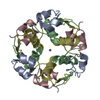
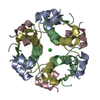
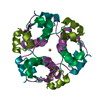
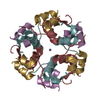
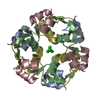
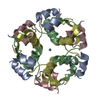
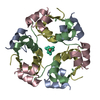
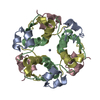
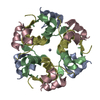
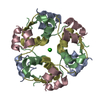
 PDBj
PDBj




















